- You are here:
- Home »
- Indoor Plants
- » Creeping Fig Care Guide
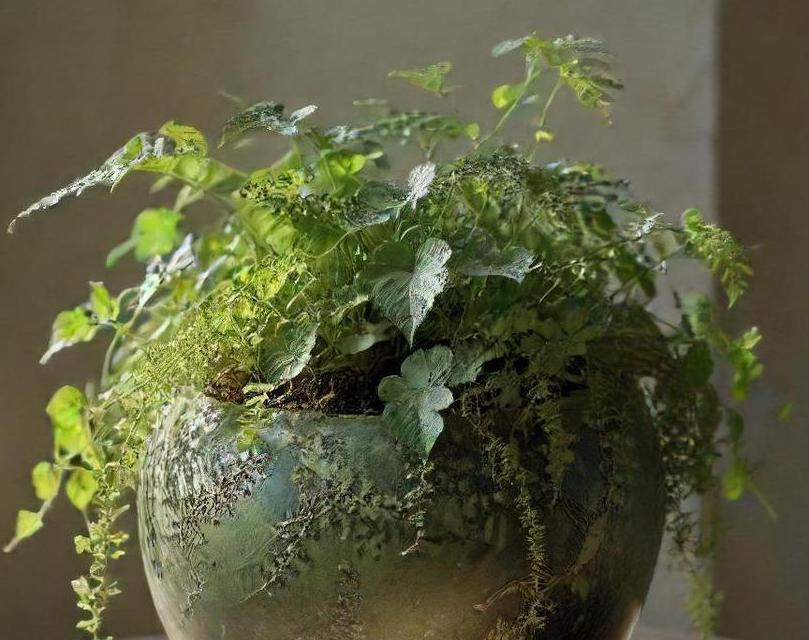
Creeping Fig Care Guide
Indoor plants have long been cherished for their ability to breathe life into our living spaces, purify the air, and add a touch of natural beauty to our surroundings. Among the myriad of options available, the creeping fig stands out as a versatile and aesthetically pleasing choice for indoor cultivation. In this comprehensive guide, we delve into the intriguing world of creeping figs, exploring their botanical characteristics, historical significance, common names, and varieties, providing you with all the information you need to cultivate and appreciate this delightful plant.
Contents
- 1 What Is Creeping Fig?
- 2 Botanical Characteristics
- 3 Historical And Cultural Significance
- 4 Common Names And Varieties
- 5 Light Requirements
- 6 Soil Requirements
- 7 Temperature Requirements
- 8 Humidity Requirements
- 9 Watering Needs For Creeping Fig
- 10 Fertilization
- 11 How To Plant Creeping Fig
- 12 Potting
- 13 Pruning Techniques For Creeping Fig
- 14 Propagation Methods For Creeping Fig
- 15 Troubleshooting Problems With Planting Creeping Fig Indoors
- 16 Conclusion
- 17 FAQS
What Is Creeping Fig?
Ficus pumila, commonly known as creeping fig, is a species of flowering plant in the mulberry family, native to East Asia. It is renowned for its vigorous growth habit and its ability to climb and cover vertical surfaces with its dense foliage, making it a popular choice for both indoor and outdoor landscaping. The name "creeping fig" aptly describes its growth pattern, as its slender stems creep and adhere tightly to walls, fences, and other structures through aerial roots, creating a striking green tapestry.
Botanical Characteristics
Appearance
Creeping fig is characterized by small, leathery leaves that are typically heart-shaped or oval in appearance, with a glossy dark green hue. The foliage is densely packed along the stems, giving the plant a lush and verdant appearance. As the plant matures, it may produce small, spherical fruits that ripen to a purplish color, although these fruits are rarely seen in indoor cultivation.
Growth Habit
One of the most remarkable features of creeping fig is its ability to climb and cling to surfaces using aerial roots. These roots secrete a sticky substance that allows them to adhere firmly to walls, creating a natural adhesive that enables the plant to scale vertical surfaces with ease. As the plant grows, it forms a dense carpet of foliage that can completely cover the surface it is growing on, adding a touch of greenery to any space.
Size
Creeping fig is a relatively compact plant, making it well-suited for indoor cultivation. In its natural habitat, it can reach heights of up to 20 feet or more, but when grown indoors, it typically remains much smaller, with the size being easily controlled through pruning and maintenance. This makes it an ideal choice for adding greenery to small spaces or for creating living walls and vertical gardens indoors.
Care Requirements
Creeping fig is relatively low-maintenance, making it an excellent choice for novice gardeners and experienced plant enthusiasts alike. It thrives in bright, indirect light but can tolerate lower light conditions, although it may not grow as vigorously in such environments. It prefers well-draining soil that is kept consistently moist but not waterlogged, and benefits from regular fertilization during the growing season to promote healthy growth.
Historical And Cultural Significance

Traditional Uses
In its native range, creeping fig has a long history of traditional use in herbal medicine and culinary applications. The leaves and stems of the plant contain compounds that are believed to have medicinal properties, and are used in various folk remedies to treat ailments ranging from skin conditions to respiratory disorders. Additionally, the fruits of the creeping fig are sometimes consumed, either raw or cooked, and are said to have a sweet and slightly tangy flavor.
Symbolism
In many cultures, creeping fig is associated with various symbolic meanings and beliefs. In some traditions, it is regarded as a symbol of prosperity and abundance, and is often grown near homes and businesses to attract good fortune and positive energy. In others, it is seen as a symbol of resilience and determination, due to its ability to thrive in adverse conditions and overcome obstacles with its tenacious growth habit.
Ornamental Use
Creeping fig has been cultivated as an ornamental plant for centuries, prized for its lush foliage and ability to add a touch of greenery to indoor and outdoor spaces alike. In traditional Chinese gardens, it is often used to adorn walls, trellises, and other structures, creating a sense of tranquility and harmony with nature. Similarly, in Japanese gardens, creeping fig is valued for its graceful appearance and ability to create beautiful living landscapes.
Common Names And Varieties
Common Names
Creeping fig is known by a variety of common names in different regions and languages. In addition to its botanical name, Ficus pumila, it is often referred to as climbing fig, creeping rubber plant, or dwarf fig, among others. These names allude to its growth habit and appearance, highlighting its climbing nature and diminutive size relative to other members of the fig family.
Varieties
There are several cultivars and varieties of creeping fig available, each with its own unique characteristics and growth habits. Some popular varieties include:
- Ficus pumila ‘Minima’: This compact variety features smaller leaves and a slower growth rate, making it well-suited for use as a ground cover or in hanging baskets.
- Ficus pumila ‘Variegata’: This variety has variegated foliage, with leaves that are mottled or streaked with creamy white or yellow markings. It adds a pop of color to indoor and outdoor spaces, and is prized for its decorative appeal.
- Ficus pumila ‘Quercifolia’: This variety is named for its oak-like leaves, which are deeply lobed and resemble those of the oak tree. It has a distinctive appearance and is often used to create visual interest in gardens and landscapes.
Creeping fig is a versatile and visually striking plant that adds beauty and greenery to indoor spaces with its dense foliage and climbing habit. With its low-maintenance care requirements and ability to thrive in a variety of environmental conditions, it is an ideal choice for both novice and experienced gardeners alike. Whether grown as a trailing vine, a ground cover, or a vertical accent, creeping fig is sure to delight with its lush growth and elegant appearance, making it a welcome addition to any indoor garden or landscape design.
Light Requirements
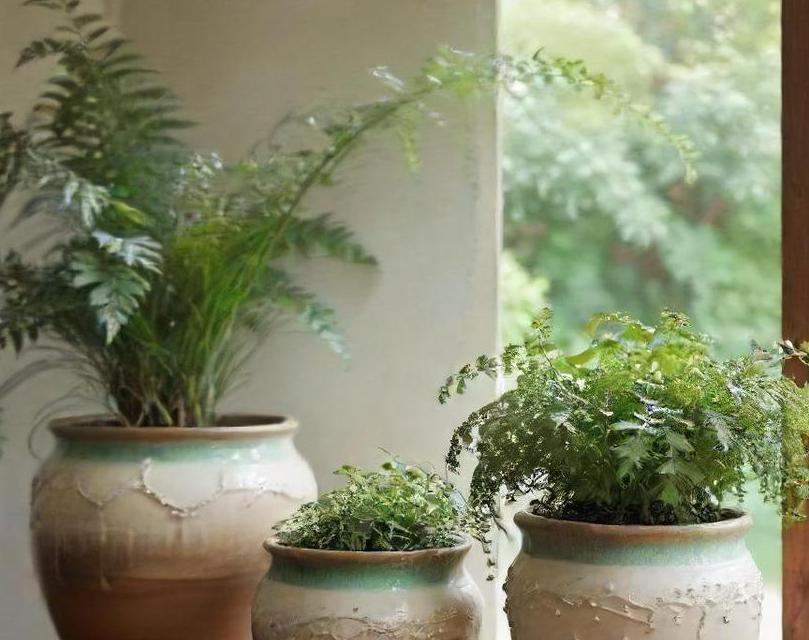
Creeping Fig, scientifically known as Ficus pumila, is a versatile and aesthetically pleasing indoor plant renowned for its lush, trailing vines and attractive foliage. Originating from East Asia, this evergreen vine has become a popular choice for indoor cultivation due to its adaptability and low maintenance requirements. Its small, heart-shaped leaves densely cover its sprawling vines, creating a lush green carpet that adds a touch of elegance to any indoor space.
Proper lighting is crucial for the healthy growth of Creeping Fig indoors. While this resilient plant can tolerate a wide range of light conditions, it thrives best in bright, indirect light. Ideally, place your Creeping Fig near a window that receives ample sunlight but avoid direct exposure to intense sunlight, which can scorch its delicate leaves.
In low light conditions, Creeping Fig may exhibit slower growth and become leggy as it stretches towards the nearest light source in search of nourishment. However, it can adapt remarkably well to low light environments, making it a suitable choice for offices or rooms with limited natural light. Supplemental artificial lighting, such as fluorescent or LED grow lights, can also be employed to ensure adequate illumination for optimal growth.
Regularly rotate your Creeping Fig to ensure even exposure to light on all sides, preventing one-sided growth and promoting balanced development. Monitoring the plant’s response to its lighting environment and adjusting accordingly will help maintain its vibrant appearance and overall health.
Soil Requirements
Selecting the appropriate soil is essential for providing Creeping Fig with a conducive growing medium that supports its vigorous growth. A well-draining potting mix with good aeration is paramount to prevent waterlogging and root rot, which can be detrimental to the plant’s health.
A blend of peat moss, perlite, and coarse sand is an excellent choice for potting Creeping Fig, ensuring adequate drainage while retaining sufficient moisture to keep the roots hydrated. Alternatively, commercial potting mixes formulated for indoor foliage plants can also provide the necessary nutrients and drainage properties for healthy growth.
When repotting Creeping Fig, choose a container with adequate drainage holes to facilitate excess water runoff and prevent water accumulation at the bottom of the pot. Repotting should be done during the plant’s active growth period in spring or early summer, allowing ample time for the roots to establish and adjust to their new environment.
Regularly check the moisture level of the soil and water thoroughly when the top inch feels dry to the touch, adjusting the frequency based on environmental factors such as temperature and humidity. Overwatering should be avoided, as it can lead to root suffocation and fungal infections, while underwatering can cause wilting and stunted growth.
Temperature Requirements
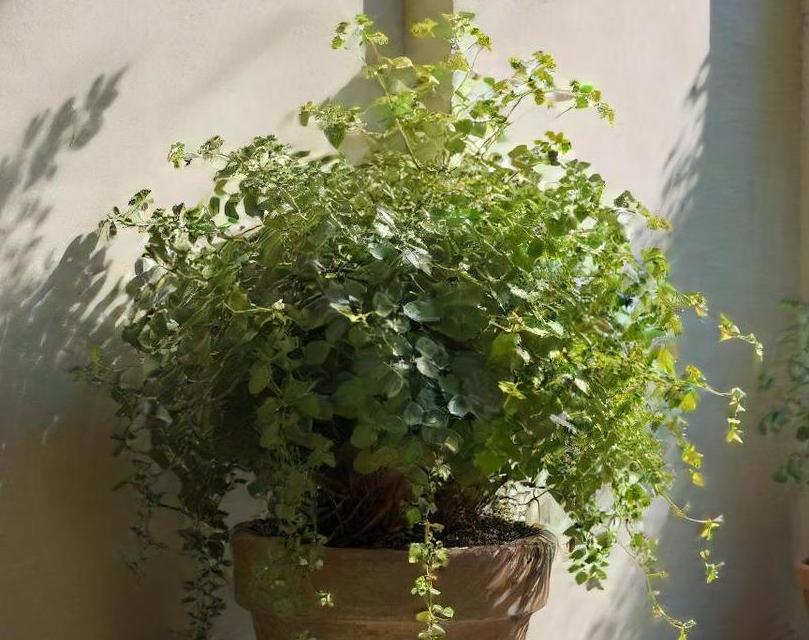
Creeping Fig thrives in moderate to warm temperatures typical of indoor environments, making it well-suited for cultivation as a houseplant. Ideally, maintain temperatures between 65°F to 75°F (18°C to 24°C) during the day and slightly cooler temperatures at night to mimic its natural habitat.
While Creeping Fig can tolerate fluctuations in temperature, it is sensitive to sudden drops or prolonged exposure to extreme cold. Avoid placing the plant near drafty windows or doors during the winter months, as exposure to cold drafts can cause leaf drop and overall decline in health.
During the summer, provide adequate ventilation to prevent overheating and ensure proper air circulation around the plant. Positioning a fan nearby on low setting can help simulate gentle breezes, promoting robust growth and discouraging pests and diseases.
In regions with harsh winters, it’s advisable to bring outdoor-grown Creeping Fig indoors before the onset of frost to protect it from cold damage. Providing consistent temperature and environmental conditions throughout the year will contribute to the overall well-being of the plant and encourage lush foliage growth.
Humidity Requirements
Maintaining optimal humidity levels is crucial for the health and vitality of Creeping Fig, especially when grown indoors where environmental conditions can vary. Originating from tropical regions, this plant thrives in moderately high humidity levels that mimic its natural habitat.
In dry indoor environments, such as centrally heated or air-conditioned spaces, humidity levels can plummet, leading to stress and dehydration for Creeping Fig. To mitigate this, increase humidity around the plant by employing various methods such as misting, grouping plants together, or using a humidifier.
Regularly misting the foliage with room temperature water helps create a microclimate of higher humidity around the plant, preventing moisture loss through transpiration and keeping the leaves hydrated. Be sure to mist early in the day to allow the water droplets to evaporate before evening, reducing the risk of fungal infections.
Grouping multiple plants together can create a localized area of higher humidity as plants release moisture through transpiration, benefiting neighboring plants including Creeping Fig. Placing a shallow tray filled with water and pebbles beneath the plant’s container can also increase ambient humidity through evaporation.
For more precise control over humidity levels, especially in dry climates or during winter months, using a humidifier is highly effective. A room humidifier can maintain consistent humidity levels, providing an optimal environment for Creeping Fig to thrive and flourish.
Creeping Fig is an exceptional choice for indoor cultivation, thanks to its resilience, versatility, and aesthetic appeal. By providing the appropriate light, soil, temperature, and humidity conditions, you can ensure the healthy growth and longevity of this charming vine as a valued addition to your indoor greenery collection. With proper care and attention to its specific requirements, Creeping Fig will reward you with its lush foliage and trailing vines, enhancing the beauty of your indoor space for years to come.
Watering Needs For Creeping Fig
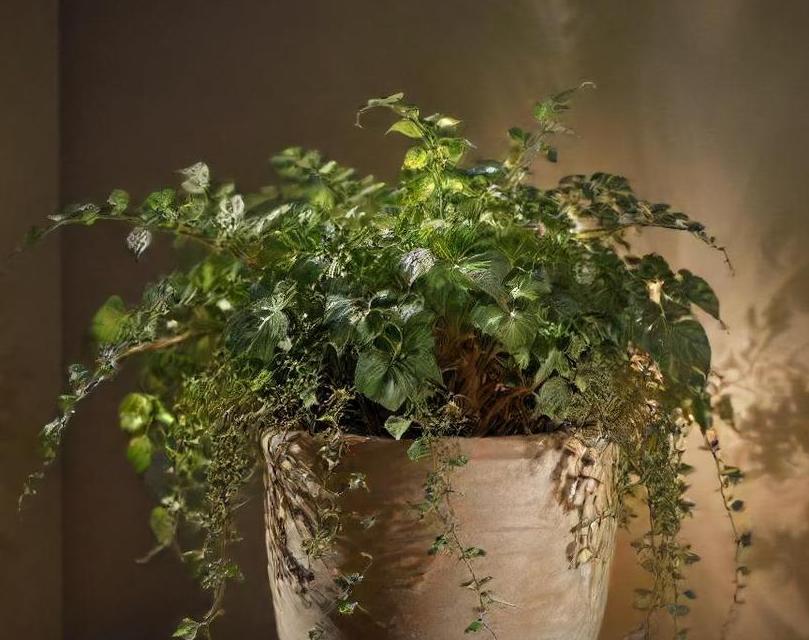
Creeping Fig (Ficus pumila) is a delightful evergreen vine cherished for its lush foliage and versatility in indoor settings. Originating from East Asia, this resilient plant belongs to the Moraceae family and is renowned for its ability to climb, making it an excellent choice for adorning walls, trellises, and containers indoors. Its small, heart-shaped leaves and fast growth rate add a touch of natural elegance to any indoor space. Understanding the optimal care requirements is essential for fostering the health and vibrancy of this charming green companion.
Proper watering is crucial for the well-being of creeping fig plants. While they prefer consistently moist soil, overwatering can lead to root rot, while underwatering may cause stress and leaf drop. The frequency of watering depends on factors such as the plant’s size, the type of container, and environmental conditions.
1. Soil Moisture: Before watering, always check the moisture level of the soil. Inserting your finger into the soil up to the first knuckle will help gauge whether watering is necessary. If the soil feels dry, it’s time to water.
2. Watering Frequency: During the growing season (spring and summer), aim to water creeping fig plants thoroughly whenever the top inch of soil feels dry. Reduce watering frequency in the dormant season (fall and winter), allowing the soil to partially dry out between waterings.
3. Watering Technique: When watering, ensure thorough saturation of the soil, allowing excess water to drain freely from the pot’s drainage holes. Avoid letting the plant sit in standing water, as this can lead to root suffocation and diseases.
4. Humidity: Creeping fig plants appreciate moderate to high humidity levels. Misting the foliage occasionally or placing a humidity tray filled with water and pebbles beneath the plant can help maintain adequate moisture levels, especially in dry indoor environments.
Fertilization
Fertilizing creeping fig plants provides essential nutrients for robust growth and vibrant foliage. However, excessive fertilization can lead to salt buildup in the soil, causing root damage. Follow these guidelines to ensure proper fertilization:
1. Fertilizer Type: Use a balanced, water-soluble fertilizer formulated for indoor plants. Look for a fertilizer with a balanced NPK ratio (nitrogen, phosphorus, potassium) to promote healthy foliage and overall growth.
2. Fertilizing Frequency: During the growing season (spring and summer), feed creeping fig plants every 4-6 weeks. Dilute the fertilizer to half or quarter strength to prevent overfeeding, as creeping figs are not heavy feeders.
3. Application Method: Apply the diluted fertilizer to moist soil, avoiding direct contact with the foliage to prevent leaf burn. Water the plant thoroughly after fertilizing to distribute the nutrients evenly and prevent salt buildup in the soil.
4. Winter Rest: Reduce or withhold fertilization during the plant’s dormant period in fall and winter. This allows the plant to rest and conserves energy for the upcoming growing season.
How To Plant Creeping Fig
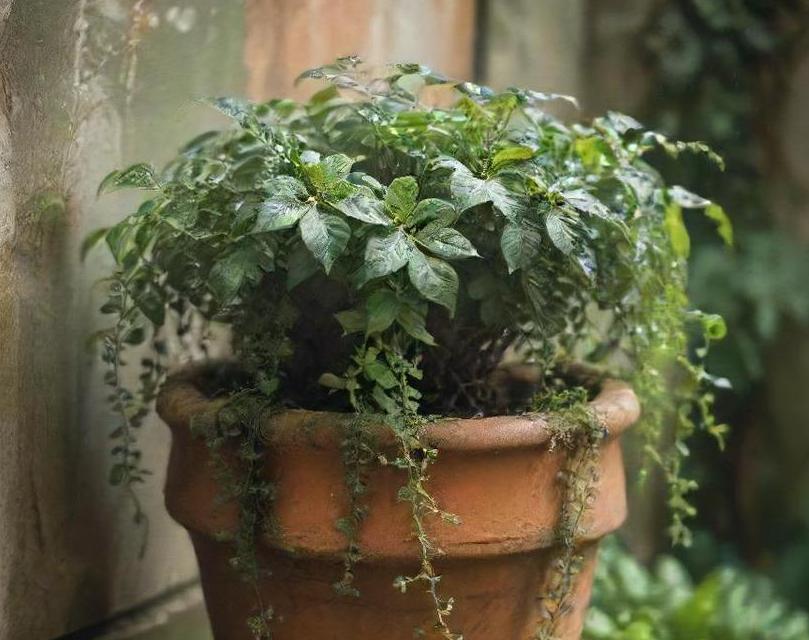
Proper planting is essential for establishing healthy and vigorous creeping fig plants. Whether you’re starting with cuttings or nursery-bought plants, follow these steps for successful planting:
1. Selecting a Container: Choose a well-draining container with ample drainage holes to prevent waterlogging. Terra cotta pots are ideal for their breathability, but any container that allows excess water to drain freely will suffice.
2. Soil Preparation: Use a well-draining potting mix formulated for indoor plants or create a blend using equal parts peat moss, perlite, and coarse sand. Avoid using heavy soils that retain excess moisture, as they can lead to root rot.
3. Planting Technique: If starting with cuttings, dip the cut end in rooting hormone to encourage root development, then plant the cutting in moist soil, burying it to the first set of leaves. For nursery-bought plants, gently remove the plant from its container and loosen the roots before placing it in the prepared pot.
4. Placement: Choose a location with bright, indirect light for optimal growth. Avoid placing creeping fig plants in direct sunlight, as it can scorch the foliage. Indoors, they thrive near east or west-facing windows where they can receive ample sunlight without being exposed to harsh midday rays.
5. Support Structure: Creeping figs are natural climbers and will benefit from a support structure such as a trellis, moss pole, or wall-mounted frame. Install the support system at planting or soon after to avoid disturbing the plant’s roots later on.
Potting
Repotting is an essential aspect of creeping fig plant care, ensuring adequate space for root growth and replenishing nutrients in the soil. Follow these steps to repot your creeping fig as needed:
1. Signs for Repotting: Monitor the plant for signs of root-bound growth, such as roots circling the pot’s bottom or emerging from drainage holes. Additionally, if the plant has outgrown its current container or shows signs of decline despite proper care, it may benefit from repotting.
2. Choosing a New Container: Select a slightly larger container than the current one, allowing room for the plant’s roots to spread. Ensure the new container has drainage holes to prevent waterlogging.
3. Repotting Process: Gently remove the plant from its current container, taking care not to damage the roots. Loosen the root ball and inspect for any signs of rot or disease, trimming away any affected roots with sterile pruners. Place the plant in the center of the new container and fill in the gaps with fresh potting mix, pressing lightly to secure the plant in place.
4. Watering After Repotting: After repotting, water the plant thoroughly to settle the soil and encourage root establishment. Allow excess water to drain freely from the pot, then place the plant in its preferred location with appropriate lighting conditions.
Creeping Fig (Ficus pumila) is a charming and adaptable indoor plant prized for its lush foliage and climbing habit. By understanding and implementing proper care techniques, including watering, fertilization, planting, and repotting, you can ensure the health and vitality of your creeping fig for years to come. Whether adorning walls, trellises, or containers, this versatile plant adds a touch of natural beauty to any indoor space, making it a beloved choice among plant enthusiasts and interior decorators alike. With attention to detail and a little green thumb know-how, your creeping fig will thrive and delight with its verdant charm.
Pruning Techniques For Creeping Fig
Creeping Fig is native to East Asia, where it naturally grows as a climbing vine in tropical and subtropical forests. Its ability to attach itself to surfaces using aerial roots makes it an excellent choice for vertical gardens, trellises, and indoor walls. When grown indoors, Creeping Fig thrives in bright, indirect light and moderate humidity levels.
One of the key attractions of Creeping Fig is its dense foliage, which consists of small, heart-shaped leaves densely packed along its stems. These leaves range in color from dark green to variegated forms with creamy-white or yellowish markings, adding visual interest to any indoor setting.
In addition to its ornamental value, Creeping Fig offers practical benefits as well. Its dense foliage can help improve indoor air quality by filtering out airborne pollutants and increasing oxygen levels. Furthermore, its trailing growth habit makes it an ideal choice for cascading down shelves or hanging baskets, adding a lush, green accent to any room.
Pruning is an essential aspect of caring for Creeping Fig, as it helps maintain its desired shape, control its growth, and promote healthy foliage. Here are some pruning techniques to keep your Creeping Fig thriving indoors:
Regular Maintenance Pruning
Regularly inspect your Creeping Fig for any dead, diseased, or damaged foliage, and promptly remove it using clean, sharp pruning shears. This not only improves the plant’s appearance but also prevents the spread of diseases and encourages new growth.
Controlling Growth
Creeping Fig has a tendency to grow vigorously, especially in optimal conditions. To prevent it from becoming too unruly indoors, trim back its stems periodically to control its growth and maintain the desired size. Focus on pruning back any long, trailing stems or overgrown sections to keep the plant compact and tidy.
Shaping
If you prefer a specific growth pattern or shape for your Creeping Fig, prune it accordingly to encourage branching and direct its growth in the desired direction. You can train it to climb up trellises or cascade down walls by selectively pruning and guiding its stems.
Renovation Pruning
Over time, Creeping Fig may become leggy or woody at the base, especially in older plants. To rejuvenate the plant and encourage fresh growth, consider performing renovation pruning by cutting back the stems close to the soil level. This encourages new shoots to emerge from the base, resulting in a denser, more compact plant.
Propagation Methods For Creeping Fig
Propagating Creeping Fig is relatively straightforward and can be done using various methods, including stem cuttings and air layering. Here are the steps for propagating Creeping Fig indoors:
Stem Cuttings
- Select a healthy stem with several nodes and leaves.
- Using clean, sharp scissors or pruning shears, cut a 4-6 inch section of the stem just below a node.
- Remove the lower leaves from the cutting, leaving only a few leaves at the top.
- Dip the cut end of the stem in rooting hormone to promote root development (optional).
- Plant the cutting in a small pot filled with well-draining potting mix.
- Water the cutting thoroughly and place it in a warm, humid location with bright, indirect light.
- Keep the soil consistently moist but not waterlogged, and mist the cutting regularly to maintain high humidity.
- After a few weeks, roots should begin to form, indicating successful propagation.
Air Layering
- Select a healthy, mature stem and make a shallow diagonal cut halfway through the stem.
- Dust the cut area with rooting hormone to encourage root development.
- Wrap the cut area with moist sphagnum moss and secure it with plastic wrap or aluminum foil.
- Keep the moss moist and secure the wrapping in place with string or tape.
- After a few weeks to a few months, roots should form within the moss.
- Once roots have developed, carefully cut below the rooted section and pot it up in well-draining soil.
Troubleshooting Problems With Planting Creeping Fig Indoors
While Creeping Fig is generally easy to care for, it may encounter certain issues when grown indoors. Here are some common problems and their solutions:
Overwatering
Symptoms: Yellowing or wilting leaves, soggy soil, root rot.
Solution: Allow the soil to dry out between waterings and adjust your watering frequency accordingly. Ensure proper drainage to prevent waterlogging.
Insufficient Light
Symptoms: Pale or leggy growth, poor foliage development.
Solution: Move the plant to a brighter location with indirect sunlight, such as near a south-facing window. Supplemental grow lights can also help improve light levels indoors.
Pest Infestations
Symptoms: Presence of pests such as spider mites, aphids, or mealybugs.
Solution: Treat the plant with insecticidal soap or neem oil, paying close attention to the undersides of leaves where pests tend to hide. Quarantine affected plants to prevent the spread of pests to other indoor plants.
Rootbound
Symptoms: Slow growth, root circling the pot, water running straight through the pot without being absorbed.
Solution: Repot the plant into a larger container with fresh potting mix, gently teasing apart any tangled roots. Trim back any excessively long or circling roots to encourage healthy growth.
Low Humidity
Symptoms: Brown leaf tips, crispy foliage, stunted growth.
Solution: Increase humidity levels around the plant by placing a humidifier nearby, grouping plants together, or placing a tray filled with water and pebbles beneath the pot. Regular misting can also help raise humidity levels.
Conclusion
Creeping Fig is a versatile and attractive indoor plant that adds beauty and greenery to any space. By following proper pruning techniques, propagation methods, and troubleshooting tips, you can ensure that your Creeping Fig thrives and flourishes indoors. Whether cascading down a bookshelf or climbing a trellis, this charming vine is sure to delight with its lush foliage and easygoing nature. With proper care and attention, your Creeping Fig will continue to adorn your home with its verdant charm for years to come.
FAQS
What Is A Creeping Fig Plant?
Creeping fig (Ficus pumila) is a species of evergreen vine that belongs to the ficus family. It is prized for its small, leathery foliage and its ability to climb and cover surfaces with its dense growth.
How Does A Creeping Fig Plant Grow?
Creeping fig is a vigorous grower that can adapt to various conditions. It typically grows as a vine, producing small aerial roots that cling to surfaces such as walls, fences, and trellises. With proper care, it can quickly cover large areas.
What Are The Light Requirements For A Creeping Fig Plant?
Creeping fig thrives in bright, indirect light but can tolerate lower light conditions. However, it may not grow as vigorously or produce as much foliage in low light. Avoid placing it in direct sunlight, as this can scorch its leaves.
How Often Should I Water My Creeping Fig Plant?
Creeping fig prefers slightly moist soil but is susceptible to root rot if overwatered. Allow the top inch of soil to dry out between waterings, and water thoroughly when needed. Reduce watering during the winter months when growth slows down.
What Type Of Soil Is Best For Creeping Fig Plants?
A well-draining potting mix is ideal for creeping fig plants. You can use a mix formulated for indoor plants or create your own by combining equal parts of peat moss, perlite, and coarse sand. Avoid heavy or compacted soils that retain too much moisture.
How Can I Propagate My Creeping Fig Plant?
Creeping fig can be easily propagated through stem cuttings. Simply take a cutting with several nodes, remove the lower leaves, and place it in a container filled with moist potting mix. Keep the cutting in a warm, humid environment until roots develop, then transplant it into a larger pot or the desired location.
Are There Any Common Pests Or Diseases That Affect Creeping Fig Plants?
Creeping fig plants are generally resilient to pests and diseases, but they may occasionally encounter issues such as spider mites, mealybugs, or scale insects. Regularly inspect your plant for any signs of infestation, and treat promptly with insecticidal soap or neem oil if necessary. Additionally, ensure good air circulation around the plant to prevent fungal diseases like powdery mildew.
